All About Watering Garlic

Watering is one of the most important ingredients in garlic care. An important role is played not only by the frequency of the procedure performed, but also by the devices with which it is carried out.
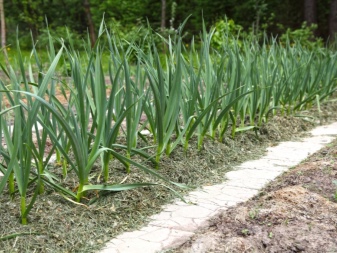
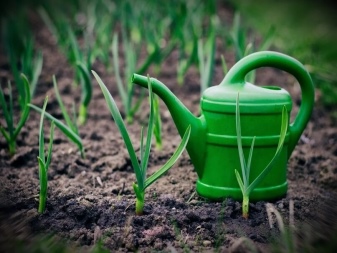
Fundamental rules
Watering garlic is allowed only in cases where when the soil temperature is more than +15 degrees - otherwise, the procedure should be abandoned. As for the liquid itself, you can irrigate the culture with warm water, which has naturally warmed up to a mark equal to +18 degrees. It is most convenient to pre-settle the liquid in a barrel. Cold water is definitely prohibited, regardless of where it was taken from: from a well or a water supply system. The same rule applies to the ice artesian variety.
It is more convenient to organize the procedure in the early morning or evening, so as not to provoke burns on the feathers. It is too late, however, it is not worth acting, otherwise the earth, dry until night, will become an ideal environment for the activity of fungi.
When watering a culture, a large amount of water is required, but it is strictly forbidden to fill it, because an underdeveloped root system is located close to the surface and it is not difficult to provoke putrefactive processes.
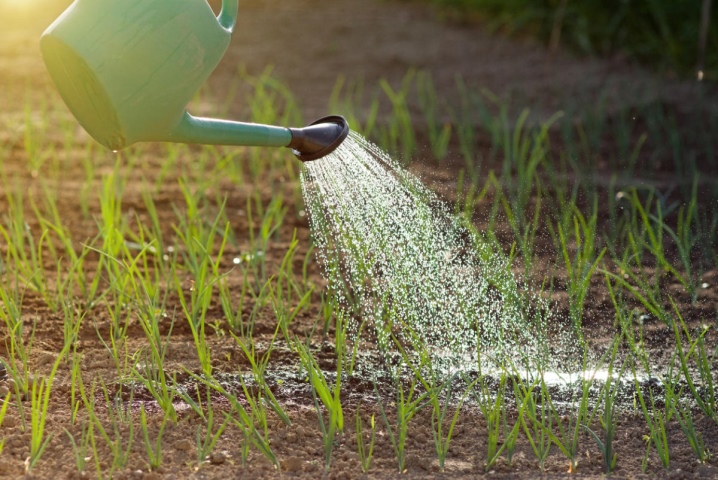
If there was rainfall the day before, then, of course, it is worth giving up watering. Also, if the heads are grown for long-term storage, then during their active growth, the frequency of moistening will have to be reduced to increase keeping quality.
The need for watering the crop depends on the moisture content of the soil. The easiest way to determine this indicator is using a special device - a moisture meter. If the device shows less than 70% moisture, then the plants need liquid.
To determine the condition of the soil without additional devices, it is necessary to dig a hole 15-20 centimeters deep and remove a lump of earth from it.

Opening your palm, you should carefully examine its contents:
- if fingerprints appear on the lump, it means that the humidity practically reaches 70%;
- for 70-75%, the design of a clear ball is also characteristic;
- crumbling earth indicates an indicator of less than 60%;
- finally, the appearance of water when the lump is squeezed indicates that the moisture level is greater than 80%.
While the soil is moistened, it is worth controlling the splash on the leaf blades.
It is important to avoid strong jets as they injure both feathers and stems, which in turn can contribute to lower yields.
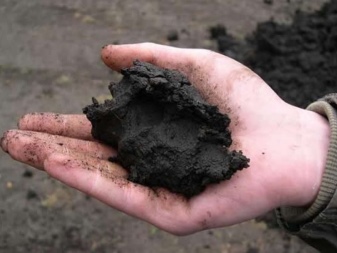
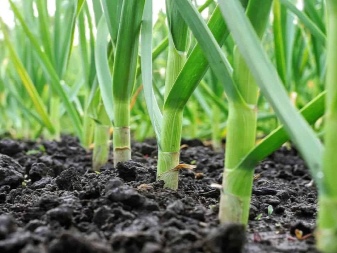
The abundant ingress of moisture on the beds can lead to the appearance of a crust, which will become an obstacle to the flow of oxygen to the forming teeth. To avoid such a situation, after both watering and prolonged precipitation, it is necessary to loosen the soil, deepening the shovel by 3-5 centimeters. The fact that there are some problems with moisture can be "told" by the plant itself... If the garlic does not have enough liquid, a whitish tint will appear on its tops, or the feathers will slightly bend at the ends. Excessive moisture leads to the blanching of the green of the crop.
Separately, it should be said about watering winter garlic, that is, the one that is planted for the winter, and ripens the next season. The need for the procedure in this case is determined depending on the weather conditions.So, if it rained a few hours before the transfer of the crop to open ground or it is expected in the coming days, then additional irrigation, of course, will not be required. If the autumn is dry, then it is worth slightly irrigating the ridge. With constant precipitation, it is important to avoid waterlogging and, if necessary, pull out grooves that prevent water stagnation. In principle, in most cases, winter garlic is not watered by the gardener at all from autumn to April-May: all this time, precipitation copes with the task.
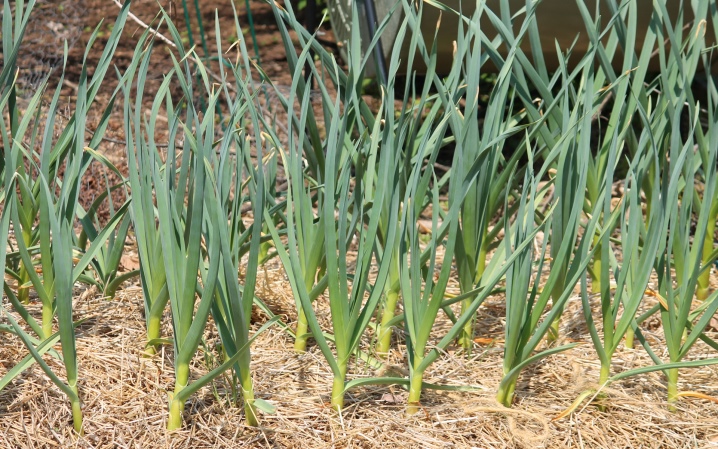
The ways
You can choose from three methods for watering your vegetable garden garlic, each with its own benefits.
Manual
Manual irrigation is the simplest way to maintain your garden beds. It does not require the purchase of special devices, but it takes up enough time and effort, and therefore it is recommended only in the case of growing small volumes or if you want to organize yourself additional physical activity.
Hand watering is considered cheap and affordable. It does not require the purchase of irrigation structures, the organization of water supply to the beds or connection to electricity, but is carried out using an ordinary watering can. However, the gardener has to spend a lot of effort, and also to move around the plantings all the time, trampling down the aisles and preventing the appearance of puddles.
In principle, a relative disadvantage can be called the fact that the amount of water poured onto the beds is extremely difficult to dose.
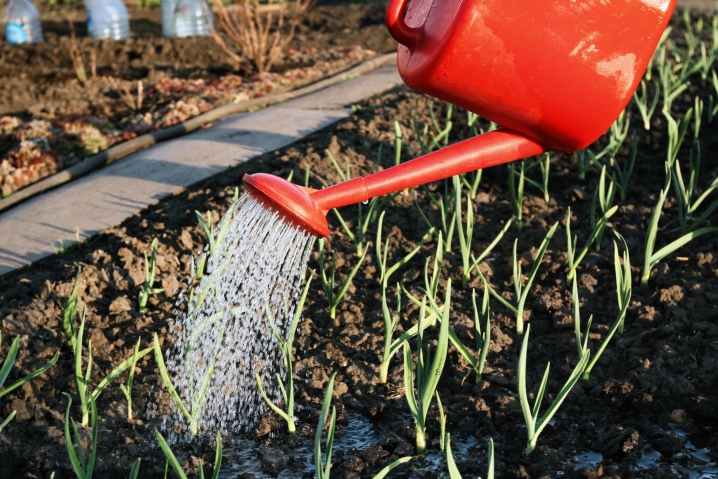
Drip
Drip irrigation is subdivided into two types: surface (ground) and subsurface (underground). If a surface system is selected for irrigation of garlic, then the water will be directed through tubes equipped with dosing devices directly to the plants. This design is laid out simply on the surface of the beds near developing crops. Ground irrigation consumes less water than sprinkling, and also does not provoke strong evaporation of moisture. Since splashes do not fall on the sheets, burns do not appear on them.
A significant advantage is the ability to apply a small amount of liquid to the beds at regular intervals.... As for the disadvantages of surface irrigation, mention should be made of the emerging difficulties in maintaining the system. The tubing will need to be changed every couple of years, and the droppers will need to be cleaned regularly. In addition, many gardeners find it difficult to assemble the system, correctly position it in the garden and, if necessary, carry out repair work.

Subsoil irrigation requires the installation of a stationary structure on the garden bed, designed to serve for several years. It functions similarly to the ground one, but, as the name suggests, tubes with thickened walls are buried underground. In addition, emitters are necessarily involved - devices that prevent the roots of garlic from penetrating into the holes of the irrigation system. This type of irrigation allows you to install the system once and forget about it for many years.
The structure, which does not interfere with other agrotechnical procedures, delivers water and nutrients directly to the root system of the crop.
However, the device will cost much more than in the case of ground irrigation. In addition, great difficulties arise in the event of a breakdown of the emitters.
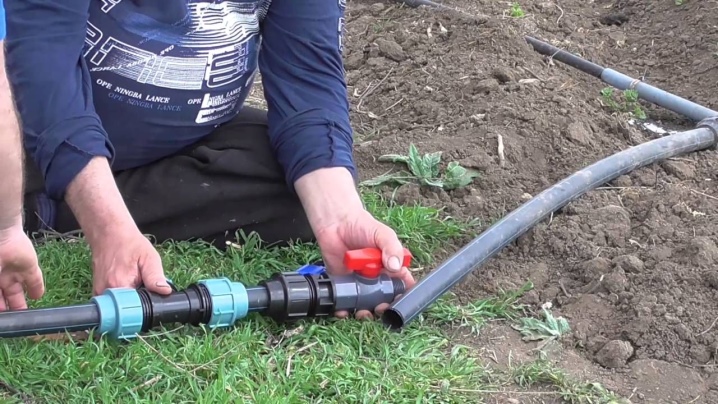
Sprinkling
Sprinkler irrigation allows you to spray water in a way that so that it falls to the ground with raindrops. To organize such abundant watering, special devices are required - spray cans fixed on the hoses. This method allows you to direct a certain amount of moisture to each plant, avoiding "distortions" in favor of one or the other specimen.
The mobile system is easy to install and remove. While working, it does not interfere with other care procedures, and also makes it possible, together with the liquid, to distribute the substances required by the culture, for example, pesticides.
Nevertheless, a number of disadvantages of sprinkling are still present. The basic fixture will cost a lot, and then will waste a lot of water, so there is no talk of saving. Irrigation can only take place under the influence of great energy that creates a water pressure.
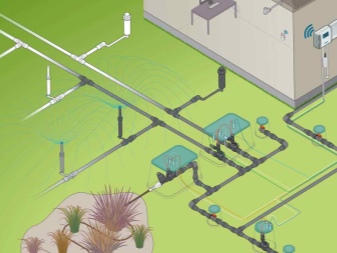
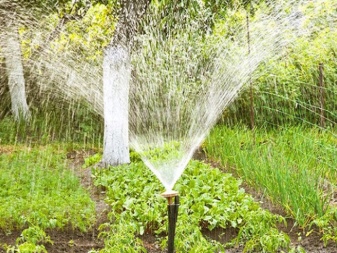
The quality of the procedure sometimes deteriorates under the influence of a strong wind blowing drops to the side. It is also considered not particularly effective on heavy soils or in dry, arid climates.
It should also be mentioned that it is sprinkling that can cause some diseases or provoke plant mineralization. This is due to the fact that a large amount of vapor appears on the surface of the beds, and this vapor transports the spores of fungi and bacteria directly to the plants.
If too much water is directed to the garlic due to the lack of automatic shutdown, this will provoke salinization of the earth, which, in turn, will negatively affect the condition of the plants.

How to water at different times?
Garlic loves moisture, and therefore needs good watering from the very beginning of the growing season.
After landing
Most often, gardeners give preference to garlic planted before winter, which begins to germinate immediately after the snowdrifts melt. If the spring is rainy, then it would be right for the first time to abandon artificial moisture, completely entrusting the task to the forces of nature.
Usually, agrotechnical measures begin at the junction of the months of April and May, although often the supply of melt water is sufficient almost until summer. From the moment of emergence to the formation of heads by the end of June, the culture requires very abundant irrigation, the frequency of which is once a week. However, if the days are dry, hot and windy, the beds have to be processed every three days.

In early May, a good solution would be to combine watering with top dressing. For example, when 3-4 leaves of garlic appear, you can add a tablespoon of urea to a bucket of water, and after a couple of weeks, dissolve a couple of tablespoons of nitroammophoska in the same amount. Moistening the ground all this time should be 30 centimeters deep, maintaining the rate of 8-10 liters per 1 sq. m.
It is also worth mentioning that spring garlic, sent to open ground in the spring, must be watered before or after planting, the earthen lump is moistened by 15-20 centimeters.
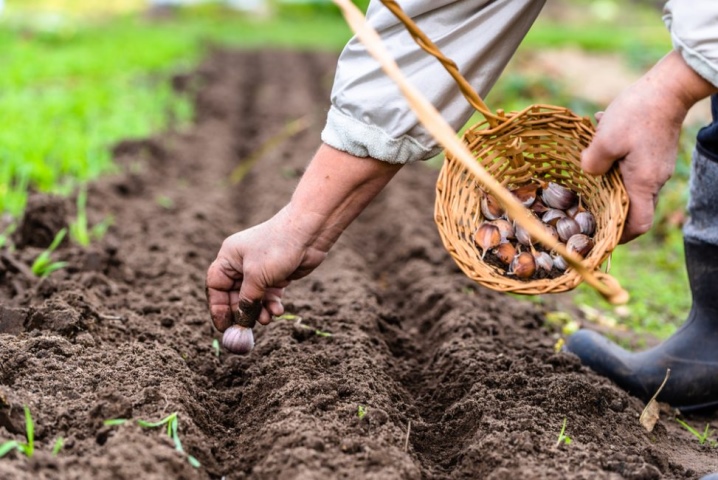
During ripening
Since the beginning of June, the soil has to be moistened at least 15 centimeters deep. Each irrigation must be accompanied by loosening to retain moisture in the ground. The rate of fluid consumption in summer increases to 10-12 liters per square meter, and the frequency of the procedure is based on weather conditions. Usually in heat it reaches once every 5-7 days, and in rainy weather - once every 14 days. By the end of the warm season, the garlic watering regime changes. The spring one is irrigated in the same way as in June - once every 7 days, and the winter one is irrigated once every one and a half to two weeks. The volume of liquid used is reduced to 5-6 liters per square meter.
It should also be noted that outdoor watering largely depends on weather conditions. Irrigation in a greenhouse is based on the condition of the soil - it is watered as soon as it dries up. As a rule, procedures in the greenhouse are carried out much more often.
Often in summer, the temperature rises above +35 degrees, and it does not rain for several weeks in a row. In this case, the culture can and should be watered every 3-4 days, not forgetting about mulching with hay, straw or grass cut from the lawn.

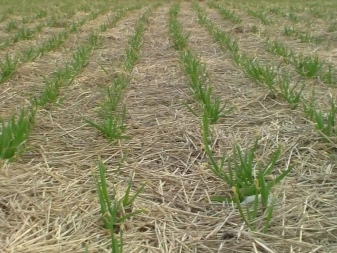
When to stop watering and why?
When to finish watering a crop is determined depending on the purpose for which it is grown. If the crop is intended for long-term storage, then they stop watering it 15-20 days, and sometimes even a whole month before harvesting. This rule, by the way, is most often used for winter crops inhabiting garden beds. The heads that need further processing are last watered about a week before digging.
The time to stop artificial wetting of plants can be slightly modified due to weather conditions, for example, prolonged rainfall or too hot weather. In the second case, irrigation is not canceled, but reduced in such a way that once every one and a half to two weeks the plant receives 5-6 liters per square meter.
By the way, the collection of spring garlic is usually planned from August 20 to September 10, and winter garlic - throughout July, therefore, when calculating the last watering, it is recommended to focus on these data.
It should also be mentioned that after removing the arrows, it is forbidden to water the culture in order to avoid the development of putrefactive processes.
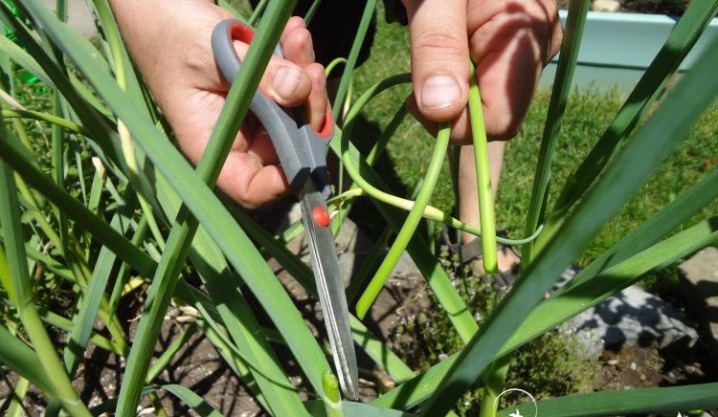













The comment was sent successfully.